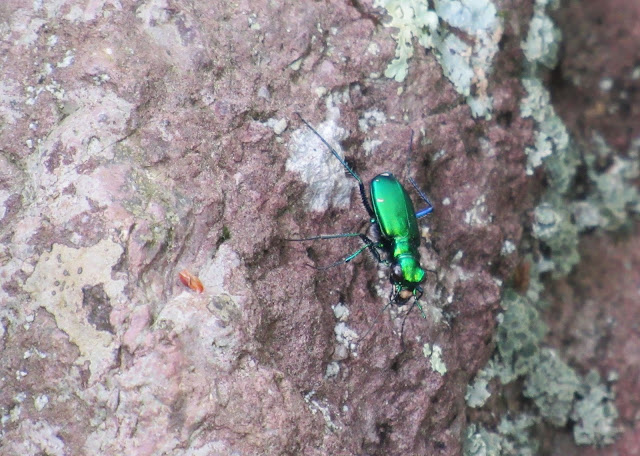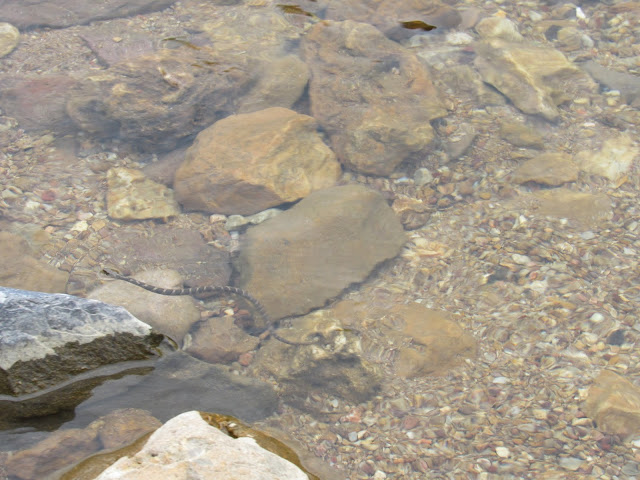Ozarks Spring 2017 Series
This is Part 1
Behold! I have returned from the Ozarks! And I was wrong about everything!
That's a trifle exaggerated, but I did just go to the Ozarks for the first time with the Lincoln Land Environmental Club, and much of what I thought I knew about the area proved to be wrong. I wasn't sure how it was going to be, but it looked fun, so we put in the work growing tomatoes to help pay for the trip, and we badgered everybody with paperwork so that we could go.
Now, a couple of nights before, I'd asked a friend about finding snakes in the Ozarks, and they mentioned to keep an eye out for Eastern Hognose Snakes. I said I probably wouldn't find any...
Not ten minutes out of the first parking lot at the first state park we visited, I nearly step on an Eastern Hognose Snake (Heterodon platirhinos), a lifer for me. Well, this was going great so far!
This particular snake species is famous for pretending to be dead when caught, but we let this one go on its way without so much as a brief display.
Half an hour later, at the same state park, a Speckled Kingsnake (Lampropeltis getula holbrooki) slithered across our path, within an arm's reach of me. I took a few quick shots and let it go on its way. This is a lifer snake I didn't expect to find here! Could the day improve any more?
Sure, let's add in some Spring Coral-root Orchids (Corallorhiza wisteriana) less than five minutes later on the same trail. At this point, I was overly blessed, and extremely happy.
Spring Coral-root Orchids don't have leaves or chlorophyll (the green stuff in plants that they use to make food), they require special mycorrhizal fungi in the dirt in order to live. These orchids steal their nutrients from fungi that borrow nutrients from forest plants. It's a complicated lifestyle that signifies a healthy forest when these are found.
The stag beetle crossing our path a bit later was unnecessary but still amazing.
Furthermore, there were so many new plants to see, like the Four-leaved Milkweed (Asclepias quadrifolia) above. Certain plants, like this species, are far more present in the Ozarks than anywhere in at least my current part of Illinois.
One of the most common species was the earlier flowering species of Beebalm (Monarda bradburiana), a plant that lives mostly in the Ozarks and Southern Illinois. Despite its range extending into Illinois, this was still a new plant for me.
Cancerweed (Salvia lyrata), which does NOT cause cancer, bloomed along the side of the trail. This is one of those plants I always associate with vacations, because I find it a lot on vacation in the South but never in Illinois. However, it does live in parts of Illinois- I just haven't found it yet. This is one of those plants that grows almost entirely south of the Mason-Dixon Line. And yes, it was named because pioneers once thought it could cure cancer, but it sadly cannot.
(Everything above this section is set apart to protect its secrecy, otherwise the snakes and orchid might be in trouble from collectors.) Sometime later in the day, we went down a trail and discovered the Shut-ins, a series of rock formations at Johnson's Shut Ins State Park:
Essentially, these "shut-ins" are really hard rocks (rhyolite) eroded over time by the flow of the stream. As a result, they make the river flow in fantastical ways through tight cracks and over rapids.
When the water's lower and warmer, this is a great place to swim, but the river was legally closed to swimming at the time of our visit. We only understood this as the Shut-ins section being closed, not the entire river. Still, most of us didn't break this rule. At least 37% of those on the trip obeyed it.
Here's your lineup of suspects. After looking at the shut-ins for awhile, three people remained below while four of us went up to a nearby trail.
We could see that the Shut-ins extended downriver, and we also found a Green Tiger Beetle:
Below the Shut-ins, the water became an un-name-able shade of blue, which looked absolutely stunning in real life. We kept trying to figure out the name of the color- was it cyan, turquoise, cerulean, or something else? We settled on cyan, I suppose, but I'm still not convinced.
At any rate, the abundant Lance-leaved Coreopsis (Coreopsis lanceolata) was unambigously yellow:
And the common Fire Pinks (Silene virginica) were RED. (Not pink, that's just the name of the plants for some reason.) These are an interesting plant in that they are abundant in the Appalacians and the Cumberland Plateau, as well as in the Ozarks, but they somewhat skip over the connecting tissue of the Shawnee Hills. They're there, but they don't appear to be as common for some reason. Basically, they live in the two upland areas outside of Illinois, but not very much in between. This helps to support the theory that the flora of the Ozarks and the Appalachians/Cumberland Plateau were once connected to each other, before being separated by the Mississippi River Valley.
We ended up going downslope to a trail along the river, where we found a Midland? Water Snake (Nerodia sipedon) swimming along in the water.
This river, the Black River, is one of the best I've ever visited. The water is clear, full of small rapids and pebble-bottomed, with little fish quite visible in it.
 Giant Swallowtail Butterflies (Papilio cresphontes), the largest species of butterfly in the United States, were quite commonly seen here, and I had never seen them before:
Giant Swallowtail Butterflies (Papilio cresphontes), the largest species of butterfly in the United States, were quite commonly seen here, and I had never seen them before:Along the trail, we eventually found a spot with a commanding view of the river:
This giant rock demanded to be climbed on, and so we did. Beforehand, I took a photo downriver:
Tayo and Nathan had already climbed up, so I took a photo of them:
We'll leave Tayo and Nathan stuck on that rock for now, because this post has gone on long enough. There's so much more to cover, but I'd rather leave it on a cliffhanger... besides, we haven't gotten to the bears yet. That was exciting!
Ebird Checklist for disclosed area:
http://ebird.org/ebird/view/checklist/S37025430






















No comments:
Post a Comment